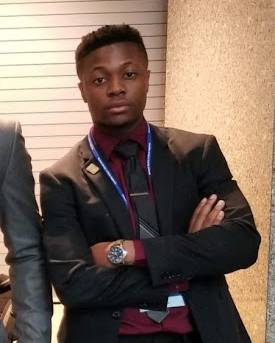Adelaide
|
What did you do this summer? |
|
I worked in signal processing with Scott Craver in the Seymour Kunis lab at the ITC.
We researched low-complexity strength synthesis. Low-complexity strength synthesis
is digitalization of a physical phenomenon; the topic we looked at was violins.
So we took a stringed instrument and we simulated it using program and micro controllers.
We generated the sound waves using the sciences behind the string stretches.
|
David
|
Adelaide
|
So how did you get involved in this project? |
|
|
I joined LSAMP my freshman year, they’re basically looking for minority students in
STEM fields. They were trying to get us engaged and give us resources that we could
use, funding for certain events like conferences. So I joined looking for that type
of relationship.
LSAMP in the summer, they linked me with the summer lab where I worked with Scott.
So I’m a frequent member during the year, then in the summer I actually do research
LSAMP knows a lot of faculty at the ITC on campus, they actually have partnerships
with them, they converse a lot. So when it actually comes time to assign research
projects, they have a whole list of professors that they contact or they have students
actually reach out to professors on their own as well, so I believe Scott was one
of the contacts that they had.
|
David
|
Adelaide
|
What was your experience like? |
| This was my second research project I did, so this one was very hands-on, I really
got to see the progression of the project from start to finish. When he introduced
it to me, he already had some files he was working with, but he wanted me to jump
on and really get it from the computer to the board. So that was really my job. He
had a basic form of the project running on a computer so he could make MP3 files or
.wav files with the computer. So he was able to basically make simulations of the
string and play it back in ten-second samples, so what he wanted me to do was to get
it to the board, and then instead of making those ten-second samples, actually make
it simultaneous so that as you play with the board, it outputs the sound.
|
David
|
Adelaide
|
How did it work? |
| The scarf has conductive thread in it so when you literally connect the circuit, it
will just do a change of voltage and when the voltage rises past a certain threshold
it will be like you’re playing the violin, and then the microcontroller will recognize
that the voltage is high enough and it will run through the system and play the note
for you. In the end, we kind of just had an on or off sensor, then we had a ribbon
sensor. The thread itself was hard to get regions of it, but with the ribbon sensor
you could just actually get that effect. If you hit the bottom, you’re hitting a certain
note, if you hit it in the middle you’re hitting a certain note.
|
David
|
Adelaide
|
What programming language did you use? |
| It was in C and we programmed it in the arduino. |
David
|
Adelaide
|
What do you do in your free-time? |
| I’m also a part of another org, NSBE—, they hold workshops—, recently they had technical
workshops where they talked to people as a group about C, MATLAB. I was formerly a
part of the E-Board, I was a part of the publication staff, I made promotional flyers
and held bake sales when we needed funding and now I’m just a frequent member, go
when they have GBMs. I joined NSBE my freshman year, I didn’t actually join the E-Board
until my junior year, so before I was actually on E-Board it was the same, going to
the events, and I actually go to their conferences.
|
David
|
|
